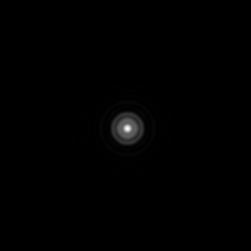Using Qcfocus for focusing
Main parameters
The On/Off button must be used before any parameters may be modified.

Refresh
rate is the value in milliseconds between images; it must be in
keeping with the camera’s capabilities in terms of exposure
time or other values provided by the camera driver.
Seeing
smoothing makes it possible to take into consideration only the
best value of a series of images in order to eliminate images
degraded by excessive turbulence.
Window size is the size in pixels of the image analysis window.
If the box Full is checked, the brightest star in the frame is selected. If unchecked, it is only necessary that the target star fall in the analysis window. Iit is therefore possible to choose a specific star for focusing by clicking on it in the image.

Principle of focusing on a star by measuring PSF
PSF (Point Spread Function) is the mathematical function which describes spreading of the image of a specific object. In the case of a perfect instrument and proper focus, it corresponds to the ideal Airy disc. One may visualize it as a curve representing light intensity as a function of distance from the center of the image.
We judge the quality of focus by eye, at the telescope, by achieving the smallest possible star image. The principle used here is identical, but in order to achieve higher precision, we try to quantify the diameter of the star image by attaching a numerical value. To simulate this method using a computational approach, it is necessary to first replace the actual PSF function (which is always rather complex) by a simpler approximation. This is done in Qfocus by means of a Gaussian distribution.
With this function, the characteristic diameter of the star image is indicated by the full width at half-maximum (FWHM) of the Gaussian distribution.
To achieve focus, it is therefore necessary to try to obtain the smallest possible value for FWHM.
The
illustrations which follow were produced by the Aberrator
program.
They correspond to a 20 cm telescope with a 20% central
obstruction, and a CCD image
scale of 0.3 arcsec per pixel.
Focused image



PSF of the defocused image

Xmax: 122.6 Ymax: 129.2 |
Xmax: 125.3 Ymax: 118.7 |
Xmax and Ymax indicate the coordinates of the center of star; FWHM is the width, in pixels, of the star image at half maximum; Elong is the relationship between FWHM in horizontal and vertical directions, indicating spot elongation; Imax is the value of the brightest pixel; Flux is the total intensity of the pixels and represents the brightness of the star.
 It should
be noted that diameter of the image decreases as brightness
increases. This can provide a secondary indicator of good focus. For
this reason, maximum intensity is represented by a graph over time,
similar to that of FWHM.
It should
be noted that diameter of the image decreases as brightness
increases. This can provide a secondary indicator of good focus. For
this reason, maximum intensity is represented by a graph over time,
similar to that of FWHM.
In practice, instrument defects, and especially atmospheric turbulence, will distort these ideal values.
Therefore one will seldom achieve the figures indicated above, but rather a broader spreading of the stellar image. To reduce the effects of turbulence, one may consider only the best value of a series of measurements; the “Seeing smoothing” parameter allows selection of the number of measurements to be considered.
In some cases, use of a Hartmann mask may improve focusing precision. This is a simple disc with two holes, attached to the front of the telescope. Away from focus, the star image is seen as double, while at focus, there is only one image visible. In this case, too, it may be advantageous to use a numerical measurement instead of a simple visual estimate.
The images below show the result obtained using two 80mm holes.
|
|
 Better |
|
The image scale is the same as before, but the diffraction disc is much larger because of the effective reduction in telescope aperture. This effect limits more extensive use of the Hartmann mask with long focal lengths.
However, this new means of measuring PSF will help. Since the FWHM value is based on the major axis of the image, it provides a good estimate of merging of the two star images. Furthermore, at perfect focus, the “Elong.” value must be equal to 1, as the image will then be perfectly round. (Remember to remove the mask before imaging a planet....)
For a more
detailed discussion of focus tolerances, see Thierry Legault’s page on
focusing. Also, if you use a Schmidt-Cassegrain,
see the comparison
of various focusing methods in this article by Alain
Kohler.

